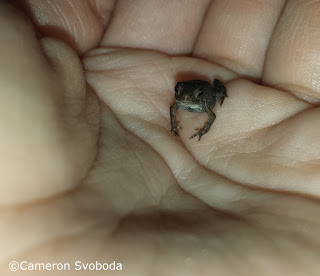It's that time of year; if you live within a few miles of a pond, lake, or stream, you could step outside one morning and come face-to-face with a 20-pound reptile! But there's nothing to worry about. In fact, you could be in for a treat. Chances are, it's a female common snapping turtle,
Chelydra serpentina, just looking for a place to lay her eggs.
Snapping turtles mate from April through November, with their peak egg-laying season in June and July. During this time, a female will stray far from water looking for sandy soil in which to dig a nest chamber. You may see her rub her nose on the ground; she's testing the soil to see if it is soft enough. When she finds a suitable location, she'll use her powerful back legs to dig a hole and deposit 10-80 (but typically 20-50) one-inch eggs that look just like ping pong balls. Then, she buries the eggs and returns to the water, never looking back. Nine out of ten nests will be raided by predators such as crows, minks, skunks, foxes, and raccoons. Often the nest will be discovered and the eggs eaten the very first night. As hatchlings they may be preyed upon by all of those animals and more, including herons and other shorebirds, birds of prey, bullfrogs, large fish, snakes, and even other snapping turtles. It's a wonder any survive at all! They are obviously doing something right though, because they've managed to stick around for over 70 million years. Snapping turtles shared the Earth with dinosaurs and are still around to share it with us. I often wonder if they preferred the dinosaurs' company to ours.
 |
The prehistoric gaze of Chelydra serpentina,
the Common Snapping Turtle. |
Snapping turtles have an unfair reputation for being vicious. On land they can be aggressive, but that's only because they are out of their element and unable to make a quick getaway. In the water, snapping turtles swim gracefully, and prefer to slip away quietly from people rather than attack. Even on land, they will usually attempt to scare you off by hissing, only snapping if you don't get the message. It is thought that they evolved their powerful snapping jaws because they are too large to hide in their shells like other turtles.
 |
A snapping turtle's nostrils are on the very tip of its snout,
effectively functioning as snorkels. |
 |
Older snapping turtles often have shells covered with
algae and leeches... Turtle soup, anyone? |
In spring, male snapping turtles wage combat to re-establish their territories. I had the privilege of witnessing a battle between two large males last year, thrashing and shoving in an aquatic Sumo match, hissing all the while. It was truly an awe-inspiring experience. I regret that, lost in the moment, it never occurred to me to press the
video button on my camera. I did, however, take plenty of pictures to chronicle the fight.
 |
Here we have two male snappers fighting over territory.
The one in front has clamped onto its opponent's neck. |
 |
Here they have decided to reconcile their differences
and are hugging it out. |
 |
| "Just kidding! I poke your eyes out!" |
Last Tuesday as I was working, a ranger called the nature center and said there was a snapping turtle in the parking lot. Naturally, my coworker and I went out to see. We watched as she made her slow way around the grassy strip between the two halves of the parking lot, occasionally rubbing her face on the ground, looking for a nesting spot. After a few minutes, we left her to her search. As I was leaving, at about 6:30 P.M., I went back to check on her progress, and lo! She had started digging a nest! Here is a short recording of her using her hind legs to dig (ignore my brother's chatter).
Had I stayed another couple of hours, I would have seen her lay her eggs. It was really tempting to stay and watch, and forget going to my sister's high school graduation ceremony. How many people can claim to have seen a wild turtle lay eggs? I did leave, though; some day I hope to come across this spectacle again, and get video of the eggs being laid.
The next morning, I anxiously went back to the nest, only to have my worst fears confirmed: it had been raided, probably by one of the park's dozens of raccoons.
 |
| The raided nest. :( |
 |
| Broken egg shells, broken dreams. |
I was upset to say the least. I really wanted to see the adorable, quarter-sized babies emerge. But, oh well, nature can be cruel.
Many turtles can be seen crossing roads at this time of year. If you see a snapping turtle crossing a road, you can help it by approaching slowly from behind, gripping the shell on either side of the tail (they have incredibly long necks and can reach all the way back to their hind legs to bite you), and carrying it across in the direction it was walking. Don't take it back the way it came from; it will just try to cross again. This applies to all turtles. You may have heard that it is safe to pick up a snapping turtle by its tail, but this should never be done, as it can damage the turtle's vertebrae. Other than to help it cross a road, please don't move any turtle you come across. It's probably a female just looking for a nesting site.


































